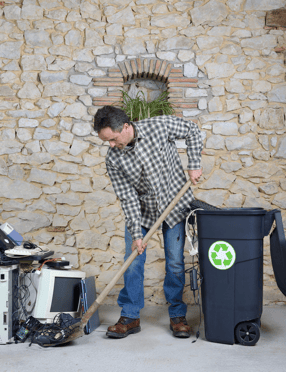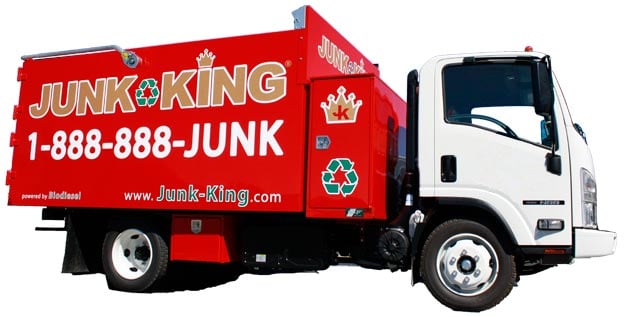Can you adopt the KonMari method to clearing out the clutter in your home without contributing to the e-waste crisis? If you follow the simple steps below, you can! Keep reading to learn how to responsibly dispose of e-waste and other items that no longer spark joy.
Japanese organizing consultant-cum-author Marie Kondo sparked more than just joy with her January 1, 2019 Netflix premiere of Tidying Up With Marie Kondo--she sparked a revolution. The series is equal parts home improvement and self help, and led to record levels of donations to charities as viewers began to apply Kondo’s method (KonMari, for the uninitiated) to their own homes. This is a repeat of the surge in donations and second hand sales of items that swept the country in 2015 after publication of her New York Time’s Best Seller “The Life Changing Magic of Tidying Up.”
How could a cleaning method have such an impact on readers and viewers alike? Organizing “gurus” aren’t new, but Kondo’s method takes a more forgiving view of the items we keep in our homes. Unlike the tenets of previous methods, those who adopt the KonMari approach do not need to justify whether they need or will use an item to keep it in their space. Instead, they need only to know if it sparks joy in their lives. Those items which don’t spark the requisite joy (which is defined so as not to omit necessary items for daily living--your spatula need not spark joy for you to keep it) are thanked and then disposed of.
Applying the KonMari method also brings with it a clear turning point for those who employ it to change their approach to consuming because Kondo’s method makes them look their clutter in the eye and feel its weight. The internet is rife with stories of those who had emotional responses while applying Kondo’s steps to their decluttering mission, and this is echoed in the show as participants grapple with the patterns that created their clutter and recognize the impact it’s had on their lives.
Following Kondo’s method, adherents are presented with the “six basic rules of tidying (listed below, as seen on KonMari.com):
- Commit yourself to tidying up
- Imagine your ideal lifestyle
- Finish discarding first
- Tidy by category, not by location
- Follow the right order (below)
- Clothes
- Books
- Papers
- Komoro (miscellaneous)
- Sentimental
- Ask yourself if it sparks joy
For all the professed benefits its adoptees attribute to it, the KonMari method is not without its detractors. With the surge in donations, charities have had to sort through and discard much of what they receive, as items being donated are not always in suitable condition. Further, adherents to the method may not take time to consider the implications of the waste they’re creating. Because the method’s in-your-face approach to confronting your clutter makes it worse before it gets better, it can create a sense of urgency to get rid of items as quickly as possible to speed it up.
Decluttering and its Impact on E-Waste
 For decades, the mantra of sustainability has been “reduce, reuse, recycle.” At first pale, this may make decluttering seem at odds with sustainability, with its implied mantra of “divide, decide, discard.” Sustainable decluttering is possible, however. Moreover, applying the standards of sustainable living need not make the process lengthier, but it certainly makes it safer: for the environment, for us, and for future generations.
For decades, the mantra of sustainability has been “reduce, reuse, recycle.” At first pale, this may make decluttering seem at odds with sustainability, with its implied mantra of “divide, decide, discard.” Sustainable decluttering is possible, however. Moreover, applying the standards of sustainable living need not make the process lengthier, but it certainly makes it safer: for the environment, for us, and for future generations.
Before you KonMari your house and start lining up your joy-less belongings on the curb, consider these “additions” the the six rules of decluttering. While the suggestions below are written in regard to electronics, they can be all applied to other materials, as well:
Commit yourself to tidying up (and to doing so sustainably)
Committing to a decluttered home using the KonMari method IS a commitment, make no mistake about it. Many who have embarked on the task report a change in how they approach future purchases, as well, applying the question “Will this spark joy?” to potential purchases. We suggest adding to this by asking “Will this spark joy for someone else?” If an item still has value and is in working condition, consider selling it to extend its life and reduce the need for the manufacture and sale of a new item.
Imagine your ideal lifestyle (and its impact on others)
If you don’t feel like taking the time to photograph your items and list them for sale, you can still work toward achieving your ideal, uncluttered lifestyle while taking care to ensure it doesn’t negatively impact others. If selling your items is undesirable, donating them is a viable option to extend their useful life. Before donating an item, however, ask yourself if you would give it to a friend or family member. If it isn’t in good enough condition for a loved one, it may not be in suitable condition for donation, either. Check with your preferred charity or their donation standards, and don’t make your clutter their problem by ignoring them.
Finish discarding first - if repurposing is impossible
While decluttering is generally accepted to result in having fewer items, consider first if any of the items marked for removal can be repurposed. Kondo herself might find this suggestion offensive, as “future-use” thinking is often how we end up with clutter in our homes. Thoughts such as “I could use this one day” or “I might wear this one day” lie behind much of the junk in our homes. Repurposing re-focuses this trap, however, by bringing the “someday” to “today” while you consider any possible alternate uses for an item before making a final judgment. If you will never wear your old tee-shirts again, will you need cleaning rags in the future? Cut them up NOW, and move them to their new place. By repurposing items , you don’t subvert the rules, you apply them thoughtfully.
It’s important to note that this approach isn’t appropriate for some, such as those with a hoarding disorder, nor is the KonMari method recommended for those with a diagnosed or suspected disorder.
Tidy by category, not by location - and not by condition
Broken items may seem to be easy to judge -- if it doesn’t work, it goes. But ask yourself: did it spark joy before it broke? If it wasn’t in need of repair, would I want to keep it and continue using it? If the answer is yes, consider repairing it first. While there are some devices that cannot be repaired, whether due to manufacturer limitations or the cost of new parts, others may be easily returned to working condition for a lower cost than replacing the item entirely.
Follow the right order - and the right disposal methods
If an items isn’t valuable enough to sell, isn’t in suitable condition to donate, and can’t be repurposed or repaired, disposal is the way to go. At this point, you should do your research and find out what disposal method is recommended. Items that can be recycled may not qualify for curbside recycling, so you may need to identify not only the disposal method that best suits your items, but also the means.
Ask yourself if it sparks joy - and know when sparking joy doesn’t matter
When considering whether your item sparks joy, consider expanding your question to reflect the value measurement you’re applying. If you live in a community that values having the newest technology for solely aesthetic reasons, this will influence your feelings toward an object. If an item sparked joy up until a new model was released, discarding it and replacing it won’t create lasting joy, either.
If an item requires rare and hazardous materials to produce, is difficult to dispose of safety, and you need it in your everyday life, it may be time to redefine joy. Does it delight you to look at a phone you bought six months ago while all of your friends have the newest model that came out three months later? It may not. Will it spark joy for future generations when they don’t have potable water because of our overconsumption habits? Definitely not. Sometimes, if it doesn’t spark joy, the right answer isn’t to dispose of it, but to deal with it.
Responsible e-waste disposal
Ready to get rid of that junk? It’s as simple as 1, 2, 3.
Let Junk King can dispose of your e-waste in a responsible, eco-friendly manner. Our professional and insured team will haul away your old electronics and other junk, and assess each item to determine the best disposal method, typically donating, reusing, or recycling up to 60%.
You can make an appointment by booking online above or by calling 1.888.888.JUNK (5865).




